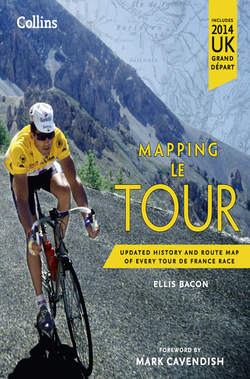Читать книгу Mapping Le Tour: The unofficial history of all 100 Tour de France races - Ellis Bacon - Страница 13
Оглавление1905
3rd Edition
| Start: Paris, France, on 9 JulyFinish: Paris, France, on 30 July | |
| Total distance: 3021 km (1877 miles)Longest stage: 348 km (216 miles) | |
| Highest point:Col Bayard: 1246 m (4088 ft)Mountain stages: 2 | |
| Starters: 60Finishers: 24 | |
| Winning time: 35 pointsAverage speed: 27.481 kph (17.075 mph) | |
| 1. Louis Trousselier (Fra) 35 points2. Hippolyte Aucouturier (Fra) 61 points3. Jean-Baptiste Dortignacq (Fra) 64 points |
Despite the race having tackled the Col de la République in its previous two editions, the third Tour de France entered new territory in 1905 by introducing its first serious, leg-crunching, lung-busting climb in the shape of the Ballon d’Alsace. It was also made up of shorter stages, albeit with an increase in their number – up to eleven from six.
After his despair at the previous year’s mass cheating, race director Henri Desgrange almost cancelled the 1905 Tour as early as its first stage, during which tacks were again thrown onto the road. All the riders punctured apart from 1904 runner-up Jean-Baptiste Dortignacq, though eventual overall race winner, Louis Trousselier, was nevertheless able to recover and win stage 1 from Paris to Nancy.
For stage 2, between Nancy and Besançon, it was out with the Col de la République and in with the Ballon d’Alsace, in the Vosges mountains. Wrongly, the Ballon d’Alsace is considered the Tour’s first major climb, but it was recognised as such by the race organisers more for its steepness than its height: at 1178 m (3865 ft), it is just 17 m (56 ft) higher than the Col de la République. Indeed, the Col Bayard, climbed later, on stage 4 of the 1905 Tour, stands at 1246 m (4088 ft).
With an average grade of 6.9 per cent, climbed from the north from the town of St-Maurice-sur-Moselle, Desgrange predicted that none of his race’s participants would be able to ride over the Ballon d’Alsace. René Pottier, however, had other ideas, stomping on the pedals to become the first rider to the top of the climb, although he was overtaken later in the stage by Hippolyte Aucouturier.
Overall race winner Trousselier – victorious thanks to five stage wins and Desgrange’s newly introduced points, rather than time, system of determining the winner – was a deserving Tour champion, but gambled his winnings away in a single, celebratory evening after the finish in Paris.
Frenchman Louis Trousselier was the first rider to win the Tour de France on points
